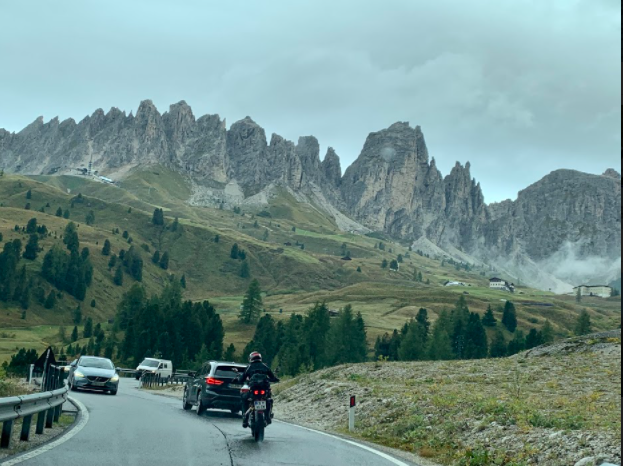

What this Blog is About
This blog describes our experience driving in Italy. We drove in Northern Italy in 2019 and again in 2021 and in Sardinia, Sicily and Southern Italy in 2022. Driving in Italy is like driving in the states where we drive on the right side of the road. However, there are a few differences that surprised us. Most notable is the abundance of speed cameras in Northern Italy. Second, interstate-like highways are few, except for toll roads. Third is that there seem to be a lot more impatient drivers. Hopefully, you will find the information here helpful.
Speed Cameras and Speed Traps
The speed cameras we saw were orange metal boxes that we fondly called “little orange men” as shown in the photo below. We saw these speed cameras predominantly in small towns and villages. Maps.me (see Car Navigation blog) would warn us “camera ahead” most of the time when were approaching a speed camera.
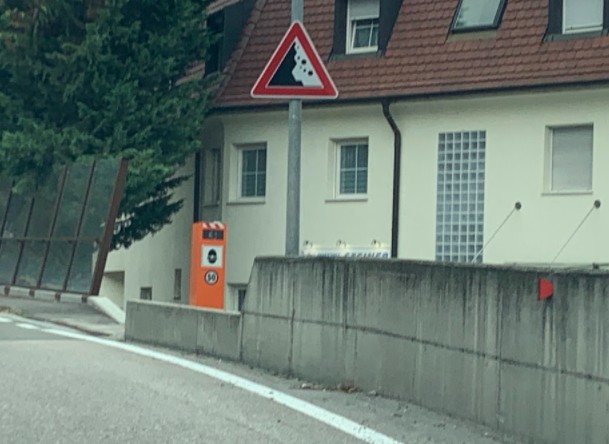

Most of the time, but not always, there will be a warning sign that we would be approaching a speed camera. These signs are typically a couple of hundred feet from the camera. So it really pays to pay attention to the road signs when driving.
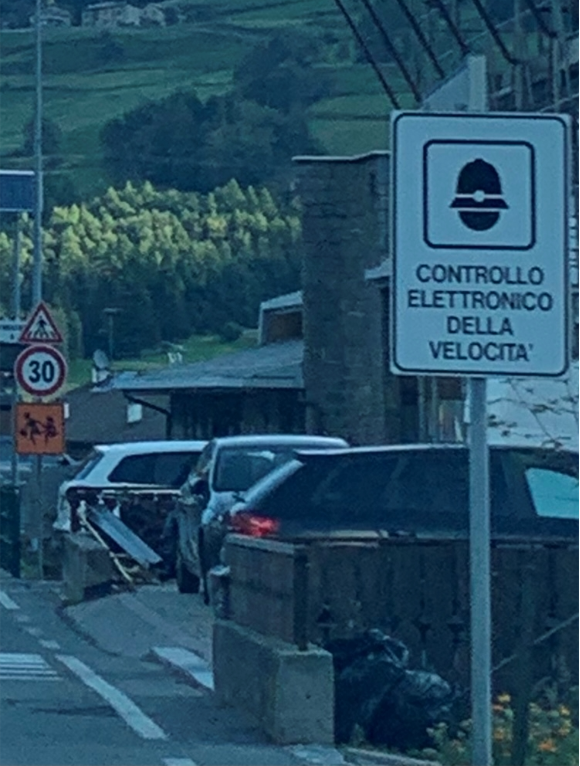

Besides speed cameras, we also saw the occasional duo of policemen on the side of the road holding a radar gun. They seem to favor the blind spots such as coming off the turn on a highway or on the downhill and making a turn. So we always had to watch our speed as any car navigation system would not provide any such warning.
Speed Limits
Italy has posted speed limits. Some locals seem to take these signs as a suggestion rather than the rule (more later). We observed that the general speed limit is posted on signs just as we crossed the the Italian border (see photo below),
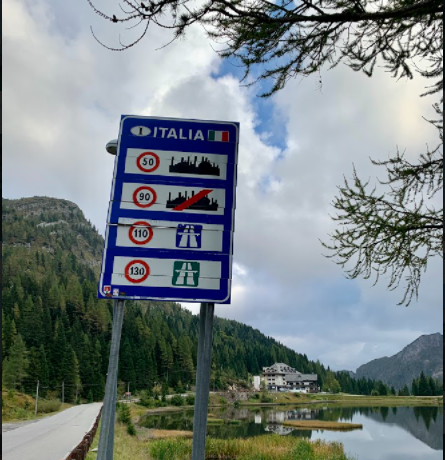

The photo above shows four speed limits depending on the location or the kind of road. Just remember that these are just general rules and that certain areas may have different posted speed limits. The first speed limit is 50 km/hr through towns and villages. We encountered 30 km/hr in some towns and villages that have really narrow roads. These narrow roads are often wide enough for only one vehicle so there is a traffic light to allow each direction of traffic to take turns (just like in a construction zone where there is only one lane of traffic open).
The second speed limit is 90 km/hr for roads that are outside of towns and villages (signified by the slash sign). These roads are typically single lane in either direction and undivided provincial roads (SP – Strada provinciale). The third and fourth speed limits are for highways. Highways are typically multi-lane in either direction and divided. The blue highway sign typically means non-toll highways like state highways (SS – Strada statale) while the green are more applicable to toll highways (A – Autostrada).
At least Google Maps is consistent with the Italian highway color designations. We had to pass through the city of Trento in one of our drives. The photo below shows the A, SS and SP highways/roads.


Highways and Local Road
Northern Italy is mountainous so interstate type of highways are few. In 2019, we drove from St. Moritz, Switzerland to Lake Como, Italy. In, 2021, we drove from Lech, Austria to Bormio, Madonna de Campiglio and Castelrotto, Italy. The highways we took were pretty much single lane in either direction going through mountains, towns and villages. There was only one toll road (A22) we took from Lago de Garda to Castelrotto which was two lanes in both directions separated by a median barrier. Italian toll roads do not require a vignette. Instead there are actual toll booths to enter and exit these toll highways.
Most of the highways in northern Italy go over the mountains unlike Austria and Switzerland where tunnels are a more common way of getting through a mountain. On our way to Bormio, we passed through 40+ hairpin turns to make it to Stelvio Pass. The hairpin turns did not really bother us. The narrow roads did not bother us either. Some sections that did not have barriers did not give us any concerns. What alarmed us the most, to the extent that it became a white knuckle driving experience, was the amount of traffic on this particular stretch of highway. Stelvio Pass is popular with bicyclist and motorcyclist. There were also busses, tour groups and private vehicles. This makes maneuvering the narrow twisting road challenging especially if you are trying to pass a cyclist pedaling his or her way to the pass. We also had to check for cyclist and motorcyclist flying downhill as well as motorcyclist who wanted to pass us before making our move to pass a cyclist pedaling up the mountain.
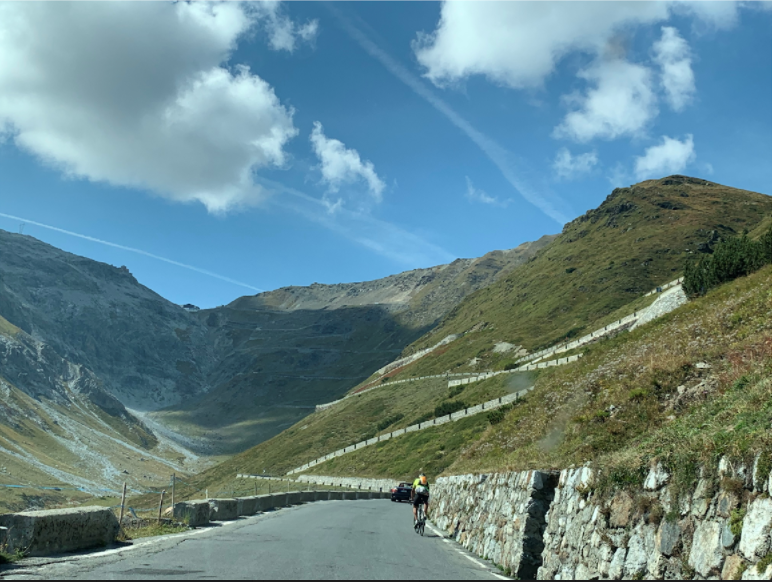

Speaking of bicyclists, some of them are also fearless. We drove past a couple of bicyclist on our way back to Bormio. The road was winding and single lane on a slight downhill. We were going 50 to 60 km/hr on the bends and sometimes up to 80 km/hr on the straightaways. Those two bicyclist decided to use our vehicle as a pace car. In some stretches, we left them behind when we can get up on speed. But they caught up to us whenever we get to the bends. They kept this up for about 20 kilometers until we reached Bormio. They even passed us when we got to Bormio where we had to slow down because of the speed limit. So please, be mindful of bicyclists when you see them on the road.
It maybe helpful to ask the locals what the road is like to your destination. We had two ways to get to Madonna de Campiglio from Bormio. The more direct route is to go through Passo Gavio while the other, more roundabout way is to go through the town of Tirano and Aprica. We planned to go through Passo Gavio until we talked to a Italian hiker. He said that Passo Gavio is worse than Passo Stelvio with the roads being more narrow and favored by more bicyclist. This made us rethink our plan with our Passo Stelvio hair raising experience still fresh. What convinced us to go the roundabout way through Tirano and Aprica was what our AirBnB host said. She said “We do not take Gavio.” Since we did not actually experience Passo Gavio, having two separate locals say the same thing was enough to convince us to take the long, but less stressful way around. The drawback, beside the longer way, is that I cannot write about the experience. Maybe next time when somebody else is driving.
We define local roads are roads that connects little towns and villages, You will inevitably have to go through these type of road if you want to venture out and explore. We drove through some really narrow roads wide enough for one vehicle. We kept on saying “I hope there is no one coming”. Lucky for us, we probably just stopped once or twice to pull over the side of the road to let the oncoming traffic pass. We think that most people are driving in the same direction during the morning and afternoon. In the morning, it seems that everybody is going to the destination while in the afternoon, everybody is returning from the destination. That or we just lucked out by not encountering a lot of opposite direction drivers during our explorations.
Impatient Drivers
We drove mainly on single lane highways through local towns on our way to Lake Como from Switzerland. At one point, we were on a section where the speed limit sign clearly shows 50 km/hr. So we naturally kept it at that. Then a truck came behind up really close and blared his horn, presumably wanting us to go faster. We had to pull over to let the truck pass, I guess for those impatient drivers, speed limits signs are just a suggestion or totally ignored. Even an older gentleman, probably in his 70’s, passed us on a downhill run on a beat up old car. I guess there are a lot of Mario Andretti in Italy.
I thought I include this funny story. We chatted with a retired Italian couple that were visiting from New York while we were on a boat cruise at Lake Como. The older gentleman (about mid 70’s) said he grew up in the Lake Como area before his parents and him emigrated to the US. I mentioned to him my experience about the impatient truck driver being on our tail and blaring its horn. I asked the old gentleman if he drove around while visiting. He said “yes”. So my next question was “Did you have the same experience I had with impatient Italian drivers?” He said “yes”. So I asked “What do you do when somebody does that?” . He said “I roll down the window and stick my middle finger out.” Guess that is what New York tough means.
We had a similar experience while driving downhill from Stelvio Pass to Bormio. The road has 30+ hairpin turns with some stretches not having any fall barriers. There was no posted speed limit so we drove between 60 and 80 km/hr (40 to 50 mph) which we considered as a safe speed. One impatient driver honked and passed us. My wife and I looked at each other and just said to each other, “He probably needed to go to the bathroom really bad.”
Sardinia, Sicily and Southern Italy
Unlike Northern Italy, driving on the highways connecting towns and cities in Sardinia, Sicily and Southern Italy is more relaxing. Yes, there are some narrow roads but traffic is far less busy. Maybe it’s because we were there in the spring (April and May) and it was off season. Whatever the reason was, we were not stressed out driving this part of Italy. Also, we did not notice any “little orange men” speed cameras.
Sardinia has one interstate-like highway running through the middle of the island. It is E25 if you look on Google Maps. We drove a short section of it and did not have to pay any toll. We drove on the west side of the island going north from Cagliari to Olbia and on the east side of the island back to Cagliari. There are mountains in Sardinia, though not anywhere close to the heights of the mountains in Northern Italy. Overall, driving in Sardinia was really enjoyable outside the cities and less stressful in the two major cities of Olbia and Cagliari compared to big cities in mainland Italy.
In Sicily, we drove around the island from Palermo airport to Messina, Taormina, Syracusa, Agrigento and back to Palermo airport. We just used public transportation to explore the city of Palermo due to difficulty in finding parking. E90 is a toll road that connects Palermo to Messina. SS113 parallels E90 most of the time, runs closer to the northern coast but takes a lot longer to travel as it winds through little towns. The toll between Palermo and Messina did not cost much in our opinion, less than 12 Euros in 2022.
From Messina to Catania is E45 which is the continuation of the mainland toll road. The toll amounts to less than 4 Euros. There is SS114 that parallels E45. It’s pretty much a no brainer to take the toll road unless you have time and enjoy driving in two lane undivided roads and little towns. The toll ends after Catania.
We did not encounter any more toll roads after Catania until we hit the E90 on our way to Palermo airport from Agrigento. Overall, the roads were less busy in Sicily compared to northern Italy and the drivers seemed a little more patient.
In southern Italy, we drove from Naples airport to Castelmezzano, Matera, Lecce and around the Puglia region. We also took the ferry from Messina, Sicily to Villa San Giovanni on our way to the beautiful cliffside town of Tropea. The only toll we encountered was the E55 and E842 on our return drive back to Naples from Martina Franca. This was a fairly long stretch and cost us around 21 Euros (in 2022) from just outside Bari to Naples airport. It took us a roundabout and two right turns to get back to the rental car parking lot from the toll exit. We did not dare drive around Naples.
Summary
Northern Italy is mountainous, has fantastic scenery and is worthy of a road trip. Most of the roads are single lane undivided highways passing through small towns and villages. Highways are few and far in between.
You will inevitably encounter bicyclists and motorcyclist on the road. They seem to favor those mountainous roads with a lot of hairpin turns. Traversing these roads can be tricky when it busy. Patience is key.
The speed limits are for the most part, clearly posted. Some local drivers ignore these signs. Resist the urge to do the same because speed cameras are also common, especially at towns and villages. Also, there maybe a couple of policemen with a radar gun just waiting for their next victim.
The highways of Sardinia, Sicily and southern Italy are a stark contrast to northern Italy. They are less stressful to drive due to less traffic and missing speed cameras. The roads are less mountainous too and the drivers seem to be more patient. Maybe because it has a more laid back atmosphere.
Related Articles
Car Navigation. Driving in Austria. Driving in Spain. Driving vs Public Transportation, Lease Vs Rent.B
